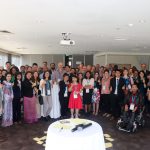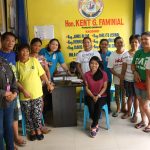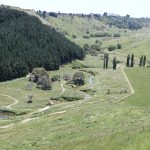12 May Emerging River Professional Award: 2016 Finalists
Three finalists from Australia and Finland have been shortlisted for the 2016 Emerging River Professional Award for their efforts to sustainably manage rivers and water.
An initiative of the International RiverFoundation, the Emerging River Professional Award (ERPA) recognises and fosters early career river professionals who have demonstrated innovation, excellence and leadership in the areas of rivers, basins, or river-dependent communities. Last year it was awarded to Tom Scarborough, Estuary Planning Coordinator for the Corangamite Catchment Management Authority in Australia, for improving community awareness and understanding about the causes of acid discharges and fish deaths in the Anglesea River.
The 2016 ERPA finalists are:
- Lee Garnett (Australia), for her work on whole of catchment urban water resource management in Queensland. Lee manages seven stormwater harvesting schemes across Brisbane City, which are projected to save 185 million litres of potable water per annum.
- Tero Mustonen (Finland), for his work incorporating traditional knowledge and science to monitor and restore watersheds in North Karelia, Finland. Tero is a post-doctoral researcher with the University of Eastern Finland and also a professional fisher, and has effectively incorporated traditional knowledge in monitoring and restoring river basins.
- Jaime Ruprecht (Australia), for his work on acid sulfate soil remediation in New South Wales. Jamie is a Project Engineer at the Water Research Laboratory at the University of New South Wales, and is currently conducting several large wetland restoration projects.
The award comprises a $5,000 prize pool, including the opportunity for each finalist to attend and present the outcomes of their work at the 19th International Riversymposium to be held in New Delhi, India from 12-14 September. The winner will be announced at the Riverprize Gala Dinner on Tuesday 13 September, and will receive a cash prize of AU$5,000.
The ERPA is generously sponsored by OceanaGold Corporation and the process is managed by the International WaterCentre Alumni Network (IWCAN).
Full profiles and project outlines are available below.
Lee Garnett (Australia)
After graduating with a Bachelor of Applied Science (Environmental Management), Lee completed an honours project investigating the impact on the quality of the downstream receiving waters from improved stormwater management practices at a working dairy farm. Lee has worked in the water industry for just over seven years, and has had several different roles within Brisbane City Council. Starting out with Brisbane City Council as a graduate water quality scientist she was responsible for their waterway monitoring programs, including data collection, analysis and reporting.
With a passion for waterway rehabilitation, Lee started taking on the management of design projects for creek restoration and water sensitive urban design. Working closely with environmental engineers and landscape architects, she was responsible for the delivery of designs within Brisbane City Council’s waterway health enhancement schedule. Moving from the technical arena into a project delivery role, Lee now works as a Project Manager for Brisbane City Council. In recent years she has been responsible for the delivery of seven stormwater harvesting schemes across the city, which are projected to save 185ML of potable water per annum. The schemes involve the collection of stormwater runoff and storage for reuse as irrigation on local parks and sports fields. Lee has developed a reputation for her knowledge of contaminated sites and successful remediation outcomes.
Lee’s project: Delivering an iconic project in urban water management
The Norman Creek 2012-2031 Master Plan was one of the first whole of catchment urban water resources management projects in Australia and draws together all existing plans, ideas and rehabilitation activities to create a ‘big picture’ guide for the future of the catchment. Implementation of the Master Plan aims to make the Vision and Concept Plan a reality, returning the Norman Creek catchment to a more natural state and revitalising it to be an environmental and recreational asset. This 20-year project is designed to achieve multiple outcomes for the city, including strengthening Brisbane’s economy, making the city cleaner, and improving access and inclusion for all residents.
Coorparoo Creek Park is the first project to be funded of the three priority precincts and involves reinstatement of an old creek and creation of a new open space in inner city Brisbane. Implementation of this unique project has provided several challenges during the detailed design phase. The detailed design was completed in 2015. Successfully delivering a detailed design that meets the project outcomes and overcomes the inherent site constraints has required advanced leadership skills to influence stakeholders and generate buy in from the project team.
Tero Mustonen (Finland)
Dr Tero Mustonen is a post-doctoral researcher with the University of Eastern Finland and a professional fisher. Dr Mustonen holds a Master of Social Sciences and PhD in human geography. Dr Mustonen has completed extended fieldwork on river ecosystems, Indigenous communities, traditional knowledge and climate change in Alaska, Canada, Siberia, Iceland, Sámi areas, Faroe Islands, Norway, Sweden, Finland, Australia, and New Zealand. He participated in the Indigenous Peoples Climate Change Assessment, Arctic Biodiversity Assessment. Dr Mustonen was a chapter author in the Arctic Resilience Report, Arctic Climate Impact Assessment and Arctic Marine Shipping Assessment and has published over twenty peer-reviewed articles in Bioscience, Biodiversity, Sibirica, Ambio, Arctic and FENNIA–julkaisuissa.
Tero’s project: Possibilities of Traditional Knowledge in Monitoring and Restoration of Rivers
Tero’s work provides cultural-social documentation of the ways in which Eurasian watersheds are changing. Central to his work are the socio-ecological systems of Northern rivers. Key method is traditional knowledge in monitoring and restoring basins combined with the latest science. Mustonen worked in five river basins of the North over the past seven years from Sweden to Siberia. Central to the work is the Jukajoki river which is located in Selkie, Mustonen’s home village. It is a 9,000 hectare middle boreal basin. It is the node of a new wave of local traditional knowledge documentation of North Karelia, Finland. Catchment area suffers from damages caused by human-induced land use. It has been the target of a systematic traditional knowledge and oral history review since 2010. Mustonen’s work has led to a catchment-wide restoration project to address the problems of acidic soils. The work has been a great success, with the establishment of a nationally relevant man-made wetland area of Linnunsuo, as well as several other smaller restoration measures that combine traditional knowledge and science. The Jukajoki work has been profiled in the US journal Foreign Policy and is the topic of a major US documentary film ‘Jukajoki’.
Jamie Ruprecht (Australia)
Jamie Ruprecht is an internationally recognised estuaries and wetlands expert specialising in field, laboratory and numerical modelling studies related to estuarine dynamics and wetland hydrology. Jamie Ruprecht has been a Project Engineer at the Water Research Laboratory for the past 6 years. Jamie holds a Bachelor of Engineering degree in Civil Engineering (First Class Honours) and a Masters in Engineering Science from UNSW Australia. He was born and raised in the Manning Valley, where his family operates a fourth generation oyster farming business on the Manning River. Jamie completed his Masters Thesis in 2015 on the stability of tidal inlets in restored coastal wetlands. Jamie was the lead project engineer working on the Big Swamp Restoration Project and the Lower Manning River Drainage Remediation Action Plan, and is currently undertaking a 3-year, water quality monitoring program at the Big Swamp site. Jamie has also recently completed several extensive boat wave-riverbank vulnerability assessments on the Hawkesbury, Clarence, and Williams Rivers, NSW. Jamie is currently working on several large wetland restoration projects (both research and applied) throughout NSW.
Jamie’s project: Understanding Catchments to Restore Coastal Landscapes: From Acidic Nightmare to Wetland Paradise
Over 17 million hectares of acid sulfate soils (ASS) have been identified worldwide, with 6.5 million hectares in Asia; 4.5 million hectares in Africa; 3 million hectares in Australia and South America; and 1 million hectares in Europe and North America. A state-of-the-art approach to remediate these soils is to encourage tidal buffering. This approach involves the removal of drainage infrastructure and the repurposing of agricultural land back to tidal wetlands. To date, remediation efforts have largely focused on individual locations at farm plot scale. Remediation projects have commonly focused on onsite acidity levels, groundwater transport and impacts to agricultural infrastructure. This site based approach provides detailed information on acid hotspots but provides limited understanding of the overall issues affecting the broader coastal floodplain.
A catchment wide estuarine dynamics approach has been developed and field tested to overcome current limitations. The catchment wide approach combines onsite investigations with large-scale studies of: (i) the fate/transport of acidic plumes, (ii) the coastal floodplain response dynamics to rainfall or flooding events, and (iii) the objective prioritisation of impacted landscapes for remediation. This paper provides a detailed description of the catchment wide approach supported by conceptual processes and a detailed case study. The 2000 hectare case study site highlights the importance of local and catchment processes in guiding rehabilitation plans.










Sorry, the comment form is closed at this time.